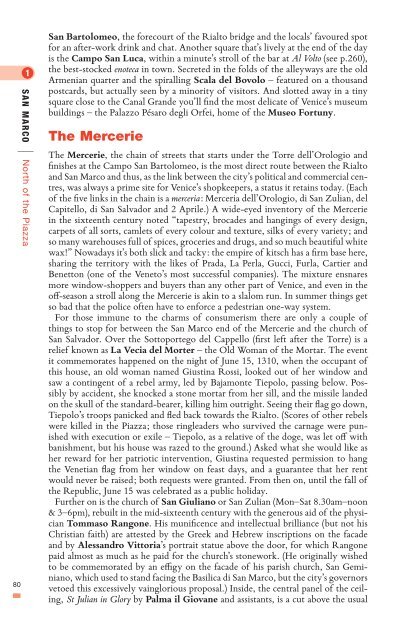Create successful ePaper yourself
Turn your PDF publications into a flip-book with our unique Google optimized e-Paper software.
san marco<br />
|<br />
80<br />
North of <strong>the</strong> Piazza<br />
San Bar<strong>to</strong>lomeo, <strong>the</strong> forecourt of <strong>the</strong> Rial<strong>to</strong> bridge <strong>and</strong> <strong>the</strong> locals’ favoured spot<br />
for an after-work drink <strong>and</strong> chat. Ano<strong>the</strong>r square that’s lively at <strong>the</strong> end of <strong>the</strong> day<br />
is <strong>the</strong> Campo San Luca, within a minute’s stroll of <strong>the</strong> bar at Al Vol<strong>to</strong> (see p.260),<br />
<strong>the</strong> best-s<strong>to</strong>cked enoteca in <strong>to</strong>wn. Secreted in <strong>the</strong> folds of <strong>the</strong> alleyways are <strong>the</strong> old<br />
Armenian quarter <strong>and</strong> <strong>the</strong> spiralling Scala del Bovolo – featured on a thous<strong>and</strong><br />
postcards, but actually seen by a minority of visi<strong>to</strong>rs. And slotted away in a tiny<br />
square close <strong>to</strong> <strong>the</strong> Canal Gr<strong>and</strong>e you’ll find <strong>the</strong> most delicate of <strong>Venice</strong>’s museum<br />
buildings – <strong>the</strong> Palazzo Pésaro degli Orfei, home of <strong>the</strong> Museo Fortuny.<br />
<strong>The</strong> Mercerie<br />
<strong>The</strong> Mercerie, <strong>the</strong> chain of streets that starts under <strong>the</strong> Torre dell’Orologio <strong>and</strong><br />
finishes at <strong>the</strong> Campo San Bar<strong>to</strong>lomeo, is <strong>the</strong> most direct route between <strong>the</strong> Rial<strong>to</strong><br />
<strong>and</strong> San Marco <strong>and</strong> thus, as <strong>the</strong> link between <strong>the</strong> city’s political <strong>and</strong> commercial centres,<br />
was always a prime site for <strong>Venice</strong>’s shopkeepers, a status it retains <strong>to</strong>day. (Each<br />
of <strong>the</strong> five links in <strong>the</strong> chain is a merceria: Merceria dell’Orologio, di San Zulian, del<br />
Capitello, di San Salvador <strong>and</strong> 2 Aprile.) A wide-eyed inven<strong>to</strong>ry of <strong>the</strong> Mercerie<br />
in <strong>the</strong> sixteenth century noted “tapestry, brocades <strong>and</strong> hangings of every design,<br />
carpets of all sorts, camlets of every colour <strong>and</strong> texture, silks of every variety; <strong>and</strong><br />
so many warehouses full of spices, groceries <strong>and</strong> drugs, <strong>and</strong> so much beautiful white<br />
wax!” Nowadays it’s both slick <strong>and</strong> tacky: <strong>the</strong> empire of kitsch has a firm base here,<br />
sharing <strong>the</strong> terri<strong>to</strong>ry with <strong>the</strong> likes of Prada, La Perla, Gucci, Furla, Cartier <strong>and</strong><br />
Benet<strong>to</strong>n (one of <strong>the</strong> Vene<strong>to</strong>’s most successful companies). <strong>The</strong> mixture ensnares<br />
more window-shoppers <strong>and</strong> buyers than any o<strong>the</strong>r part of <strong>Venice</strong>, <strong>and</strong> even in <strong>the</strong><br />
off-season a stroll along <strong>the</strong> Mercerie is akin <strong>to</strong> a slalom run. In summer things get<br />
so bad that <strong>the</strong> police often have <strong>to</strong> enforce a pedestrian one-way system.<br />
For those immune <strong>to</strong> <strong>the</strong> charms of consumerism <strong>the</strong>re are only a couple of<br />
things <strong>to</strong> s<strong>to</strong>p for between <strong>the</strong> San Marco end of <strong>the</strong> Mercerie <strong>and</strong> <strong>the</strong> church of<br />
San Salvador. Over <strong>the</strong> Sot<strong>to</strong>portego del Cappello (first left after <strong>the</strong> Torre) is a<br />
relief known as La Vecia del Morter – <strong>the</strong> Old Woman of <strong>the</strong> Mortar. <strong>The</strong> event<br />
it commemorates happened on <strong>the</strong> night of June 15, 1310, when <strong>the</strong> occupant of<br />
this house, an old woman named Giustina Rossi, looked out of her window <strong>and</strong><br />
saw a contingent of a rebel army, led by Bajamonte Tiepolo, passing below. Possibly<br />
by accident, she knocked a s<strong>to</strong>ne mortar from her sill, <strong>and</strong> <strong>the</strong> missile l<strong>and</strong>ed<br />
on <strong>the</strong> skull of <strong>the</strong> st<strong>and</strong>ard-bearer, killing him outright. Seeing <strong>the</strong>ir flag go down,<br />
Tiepolo’s troops panicked <strong>and</strong> fled back <strong>to</strong>wards <strong>the</strong> Rial<strong>to</strong>. (Scores of o<strong>the</strong>r rebels<br />
were killed in <strong>the</strong> Piazza; those ringleaders who survived <strong>the</strong> carnage were punished<br />
with execution or exile – Tiepolo, as a relative of <strong>the</strong> doge, was let off with<br />
banishment, but his house was razed <strong>to</strong> <strong>the</strong> ground.) Asked what she would like as<br />
her reward for her patriotic intervention, Giustina requested permission <strong>to</strong> hang<br />
<strong>the</strong> Venetian flag from her window on feast days, <strong>and</strong> a guarantee that her rent<br />
would never be raised; both requests were granted. From <strong>the</strong>n on, until <strong>the</strong> fall of<br />
<strong>the</strong> Republic, June 15 was celebrated as a public holiday.<br />
Fur<strong>the</strong>r on is <strong>the</strong> church of San Giuliano or San Zulian (Mon–Sat 8.30am–noon<br />
& 3–6pm), rebuilt in <strong>the</strong> mid-sixteenth century with <strong>the</strong> generous aid of <strong>the</strong> physician<br />
Tommaso Rangone. His munificence <strong>and</strong> intellectual brilliance (but not his<br />
Christian faith) are attested by <strong>the</strong> Greek <strong>and</strong> Hebrew inscriptions on <strong>the</strong> facade<br />
<strong>and</strong> by Aless<strong>and</strong>ro Vit<strong>to</strong>ria’s portrait statue above <strong>the</strong> door, for which Rangone<br />
paid almost as much as he paid for <strong>the</strong> church’s s<strong>to</strong>nework. (He originally wished<br />
<strong>to</strong> be commemorated by an effigy on <strong>the</strong> facade of his parish church, San Geminiano,<br />
which used <strong>to</strong> st<strong>and</strong> facing <strong>the</strong> Basilica di San Marco, but <strong>the</strong> city’s governors<br />
ve<strong>to</strong>ed this excessively vainglorious proposal.) Inside, <strong>the</strong> central panel of <strong>the</strong> ceiling,<br />
St Julian in Glory by Palma il Giovane <strong>and</strong> assistants, is a cut above <strong>the</strong> usual







